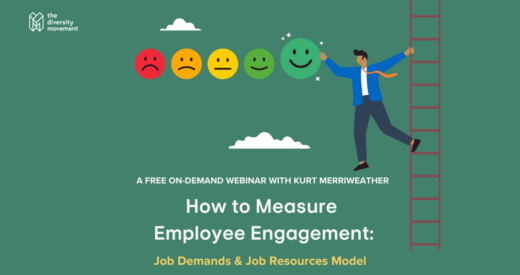As a DEI leader at your company, you’ve been routinely surveying your employees about diversity, equity, and inclusion in the workplace. However, you’ve noticed a disturbing trend: a significant, steady decline in response rates. Some employees are not even opening the survey invitation email. Some aren’t following the survey instructions correctly. Others are leaving many non-required fields blank. Comment fields are empty or filled with the same few perfunctory words.
The problem is survey fatigue, and it seems to be going around.
DEI practitioners, in particular, can’t afford to ignore survey fatigue. If employees aren’t responding to surveys, it hampers leadership’s ability to gather meaningful data, take corrective action, and judge the company’s return on DEI investment.
The proliferation of easy-to-use survey software along with a hunger for data result in a flood of surveys. People are bombarded with requests for information – from the workplace to the doctor’s office to the grocery store.
“Survey fatigue is real,” says Stephen King, a talent research methodologist in RTI International’s Human Resources Talent Research program. “Think of it like this: An employee has a piggy bank’s worth of survey responses in them, and each one of these surveys takes out a coin or two or three or five, and it depletes this piggy bank of survey responses.”
A successful DEI program can transform company culture for the better and strengthen organizational performance. This success is driven, in large measure, by gathering honest and forthright employee feedback and ensuring that all voices are heard. DEI practitioners are responsible for establishing open channels of communication and facilitating an active employee listening program. Surveys are key to this effort.
Surveys also show employees that you’re interested in monitoring progress and improving the workplace culture.
Successful, inclusive organizations need to conduct surveys, and to do so proactively and routinely, not just reactively when issues arise. But survey effectiveness falls flat when too few employees respond or do so half-heartedly.

How can you inspire employees to fill out surveys? And how can you generate the thoughtful, honest, forthright answers you need to enhance your DEI programming and support organizational transformation? Here is our prescription for survey fatigue:
Start with the End in Mind
If you sit down to design a new survey because “it’s time to do our next one,” stop right there. The root cause of your survey fatigue problem lies in treating this as a routine task rather than a strategic tool. Focus on developing a research question that you want to answer and then develop survey items that will gather data to answer that question, recommends King.
It’s all too easy to load a survey with interesting but irrelevant questions. Instead, think about what specific information will help you to make better decisions and improvements. In what ways and areas can your company realistically act? Consider the actionable information your company is seeking. The word actionable is key.
Keep in mind that surveys also set employee hopes and expectations. They anticipate that changes will be made as a result of their input, and if they don’t see any follow-through, their motivation to respond to surveys will decrease.
Select the Best Approach
Remember that surveys are most effective for gaining quantitative data. Surveys are less effective at gathering qualitative data – employees’ feelings and opinions. “If you need to know the ‘why’ behind something, consider conducting doing focus groups or one-on-one interviews with staff,” said King. “Surveys can tell you what, where, and when but qualitative data collection can tap into the why and add depth to survey data.” Also, consider whether you need feedback from all employees or just from one group or department.
Make a Communications Plan
Create a written schedule of the steps you will take to promote the survey. These can include gaining commitments from influential senior leaders to encourage employee participation, integrating video messages, newsletter articles, and a reasonable number of reminders from unit or department leaders.
Additionally, schedule future communications about the follow-up actions that have been taken in response to the survey input. Make sure that employees know that the actions you’re taking are the result of the survey.
Address “What’s in it for Me?”
Remember that each employee needs a personal motivation to respond. Emphasize topics employees care about. Confirm that the information they provide will help your company make substantive changes that benefit them. You might even provide an incentive by entering every respondent into a drawing for an enticing prize.
Ensure Anonymity or Confidentiality
To get honest and forthright answers, assure employees that their responses will be either anonymous or treated as confidential. One effective way to guarantee this is to arrange for a third-party partner to receive and analyze the responses.
If an incentive is used, the prize drawing should be entirely separate from the survey. After they submit their completed questionnaires, respondents should receive a separate link to enter their name into the drawing, ensuring their survey responses are anonymous.
Make Responding Simple and Rapid
Respect employees’ time by keeping the number of questions to a minimum. Confirm up front how many minutes will be needed. Keep question language clear and unambiguous, with one focus per question. Keep number and ranking scales consistent throughout. Use survey software that provides expert advice for choosing the right question format (yes/no, multiple choice, ranking, etc.) and that estimates average response time and completion rates. Remember that assessing responses to open-ended comment fields is time-consuming and challenging, especially with large employee groups, so use these sparingly.
Define Baseline Statistics to Measure Progress
Consider identifying several key questions that you will consistently repeat in every survey. For example, these questions might address the respondent’s overall satisfaction with the company, or how likely they are to recommend your company to potential job candidates. By establishing a baseline statistic, you can measure trends and progress over time.
Consider the Cadence
How frequently should you send DEI-related employee surveys? There are no hard and fast rules. Once again, the answer depends on what information you are hoping to gain and how quickly you can take action on what you learn. Maintaining a consistent survey schedule conveys to employees that your company is always open to their input and considers it highly useful and valuable. In addition to an annual engagement survey, many companies have added pulse surveys to their employee listening program. Pulse surveys are more frequent check-ins that are typically very short (1-4 questions) and not bound to specific topics or content. Pulse surveys can help you to measure changes in attitudes over time, act as an early warning system for impending issues, and measure the effectiveness of current programs.
Act on Survey Results and Publicize Your Actions
While many attribute survey fatigue to outreach that is too frequent and time-consuming, research by McKinsey and others has revealed the true, primary cause: Respondents don’t think that the organization will act on the survey results. The good news is that by consistently taking action based on survey input – and publicizing the success of those actions – you can create a cycle of continuous improvement, including higher survey response rates over time.
By designing each survey with the end in mind, and carefully considering what information your company needs to drive positive change, your survey results will give you what you need to take meaningful action. Then use multiple channels to spread the word throughout your entire organization about the actions taken and the resulting benefits. Continue to follow up with this one-two punch of action and communications. This process will prove that your company is actively listening, fight survey fatigue, and strengthen employee trust. They’ll know that responding to surveys is well worth their time.
Curious how to turn survey responses into an actionable DEI plan? Analytics by The Diversity Movement can help you make sense of your data, identify powerful stories to drive engagement, and advance your DEI goals faster. Analytics by The Diversity Movement combines a powerful survey tool with dashboards that support real-time segmentation to track your overall diversity, equity, and inclusion progress, gaps, and opportunities for growth. This enables organizations to visualize sentiment and pinpoint areas of the business that need attention, while still providing a holistic view of your DEI progress. Contact us today for more information or visit thediversitymovement.com/analytics.
Kurt Merriweather, CDE, is an accomplished product strategist and business executive. He is co-founder and Vice President of Innovation at The Diversity Movement. Connect with him on Linkedin.






